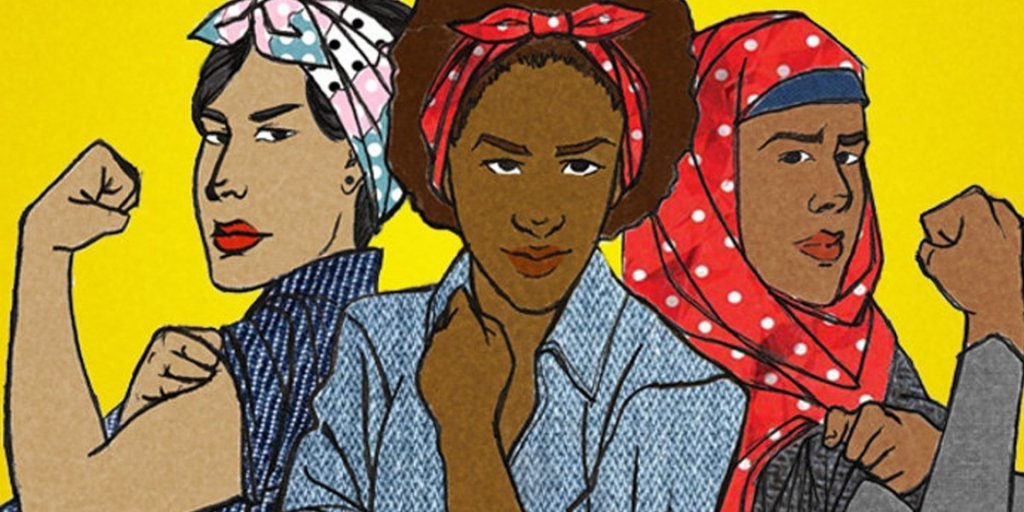The Different Branches of Feminism


Reviewed and approved by the psychologist Sergio De Dios González
Feminism is a social and political movement that reveals and criticizes the inequality between sexes and genders while claiming and promoting the interests and rights of women. It’s a movement that arose as a result of women becoming aware of their subordinate status in society.
However, today there’s still great confusion regarding this term. In fact, it’s common to find phrases in the media in which feminism is taken as a synonym or antonym of machismo, which is wrong in both cases.
In this article, we’ll study the concept of feminism, and explain why it isn’t comparable to machismo.

The three waves
Movements fighting for equality were born in the eighteenth century. They were linked to the French Revolution. However, it was a century later when the concept of the emancipated woman was born.
Since then, feminism has tended to be seen as a sequence of historical waves. Nevertheless, we must bear in mind that these stages were preceded by works of a feminist nature, even before the term ‘feminism’ appeared.
- The first wave emerged throughout the nineteenth and twentieth centuries, mainly in England and the United States. During this first period, women fought for rights in marriage. After this, they fought for the right to vote (suffrage).
- The second wave focused on claiming rights. For instance, family, sexual, labor, and reproductive.
- The third wave (from 1990 to the present day) seeks to fix the errors of the second wave. In other words, to show that women can develop in multiple spaces, take risks, and be competitive and independent. This wave is related to the liberation of women. It’s based on solidarity and support: on sisterhood.
Basic points for understanding feminism
Firstly, and as we mentioned before, feminism has a long history and isn’t something new. Therefore, it’s necessary to know how to position the movement in each historical moment and understand its birth and evolution. In this way, we’ll be able to understand how it’s currently developing.
In order to understand feminism, it’s important to recognize that it doesn’t seek the superiority of women over men, but rather equality in social, cultural, and economic aspects.
When talking about a search for equal rights, men have an extremely important role in feminism. This means that they’re also part of the movement.
Feminism defends the viewpoint that we’re all different. It doesn’t seek that women and men be considered the same, but that there should be equal rights and opportunities for both.
Feminism isn’t related to a way of dressing. In fact, it defends the idea that women have the freedom to choose what they decide to wear.
Types of feminism
Despite the origins and bases that have established the feminist movement, it’s also been dividing and acquiring different characteristics in different branches of society.
Radical feminism
This movement enjoys great popularity and is related to anti-capitalism, Marxism, environmentalism, anti-militarism, anti-racism, anti-liberalism, and pacifism. It’s the movement that defends that we have to fight against patriarchy, the system that prevails in much of the world.
Abolitionist feminism
This branch takes on the characteristics of radical feminism and, in addition, openly positions itself against prostitution, pornography, and surrogate motherhood.
Transfeminism
This is related to queer theory and has recently been gaining strength. It argues that both gender and biological sex are social constructions.
Equality feminism
It shares with the previous branches the idea that gender roles don’t exist and that they’re a consequence of the education and culture we receive at birth. It’s based on the idea held by Simone de Beauvoir that “one is not born, but rather becomes, a woman.”
The feminism of difference
Unlike the feminism of equality, this branch doesn’t defend a duality that must be equated. Instead, it claims feminine nature has its own characteristics. It encompasses the idea that “Being a woman is beautiful”. This movement flourished in France and the United States during the 1970s.
Socialist feminism
This holds that women suffer oppression, not only from the patriarchy but from capitalism as well. It argues that women are a group, as such, a social class.

Ecofeminism
Ecofeminism maintains that patriarchy equates women with nature and exerts a force of superiority, exploitation, and oppression against both. Women are understood as the driving force behind an ecological revolution.
Philosophical feminism
This branch explains that philosophy must be revised because it leaves out female authors and their ideas. In fact, gender bias has developed in the academic discipline of philosophy over time.
Factual or scientific feminism
It defends equality of opportunity. It recognizes that there are biological differences between men and women. These differences are assumed without being an impediment to effective equality.
All cited sources were thoroughly reviewed by our team to ensure their quality, reliability, currency, and validity. The bibliography of this article was considered reliable and of academic or scientific accuracy.
- Aguilar, N. (2020). Una aproximación teórica a las olas del feminismo: la cuarta ola. FEMERIS: Revista Multidisciplinar de Estudios de Género, 5(2), 121-146. https://e-revistas.uc3m.es/index.php/FEMERIS/article/view/5387
- Brunell, L. (4 de septiembre de 2023). Feminism. Encyclopedia Britannica. Consultado el 4 de octubre de 2023. https://www.britannica.com/topic/feminism
- Ferguson, K. E. (2017). Feminist theory today. Annual Review of Political Science, 20, 269-286. https://www.annualreviews.org/doi/abs/10.1146/annurev-polisci-052715-111648
- Enciclopedia Humanidades. (11 de septiembre de 2018). Movimiento feminista. Consultado el 4 de octubre de 2023. https://humanidades.com/movimiento-feminista/
- Freit Universitat Berlin. (s.f). Feminismo. Freit Universitat Berlin. Consultado el 5 de enero de 2020. https://www.lai.fu-berlin.de/es/e-learning/projekte/frauen_konzepte/projektseiten/konzeptebereich/ba_feminismo/contexto/index.html
- Garrido, C. (2021). Repensando las olas del Feminismo. Una aproximación teórica a la metáfora de las” olas”. Investigaciones Feministas, 12(2), 483-492. https://dialnet.unirioja.es/servlet/articulo?codigo=8020482
- La Vanguardia. (8 de marzo de 2018). ¿Cuál es la definición de “feminismo”? Una pista: no es lo contrario de “machismo”. Consultado el 5 de enero de 2020. https://www.lavanguardia.com/vida/20180308/441353733657/definicion-feminismo-fundeu.html
- Rampton, M. (25 de octubre de 2015). Four Waves of Feminism. Pacific University Oregon. Consultado el 4 de octubre de 2023. https://www.pacificu.edu/magazine/four-waves-feminism
- Stanford Enciclopedia of Philosophy. (14 de julio del 2023). Feminist Philosophy. Stanford Enciclopedia of Philosophy. Consultado el 4 de octubre de 2023. https://plato.stanford.edu/entries/feminist-philosophy/
This text is provided for informational purposes only and does not replace consultation with a professional. If in doubt, consult your specialist.








